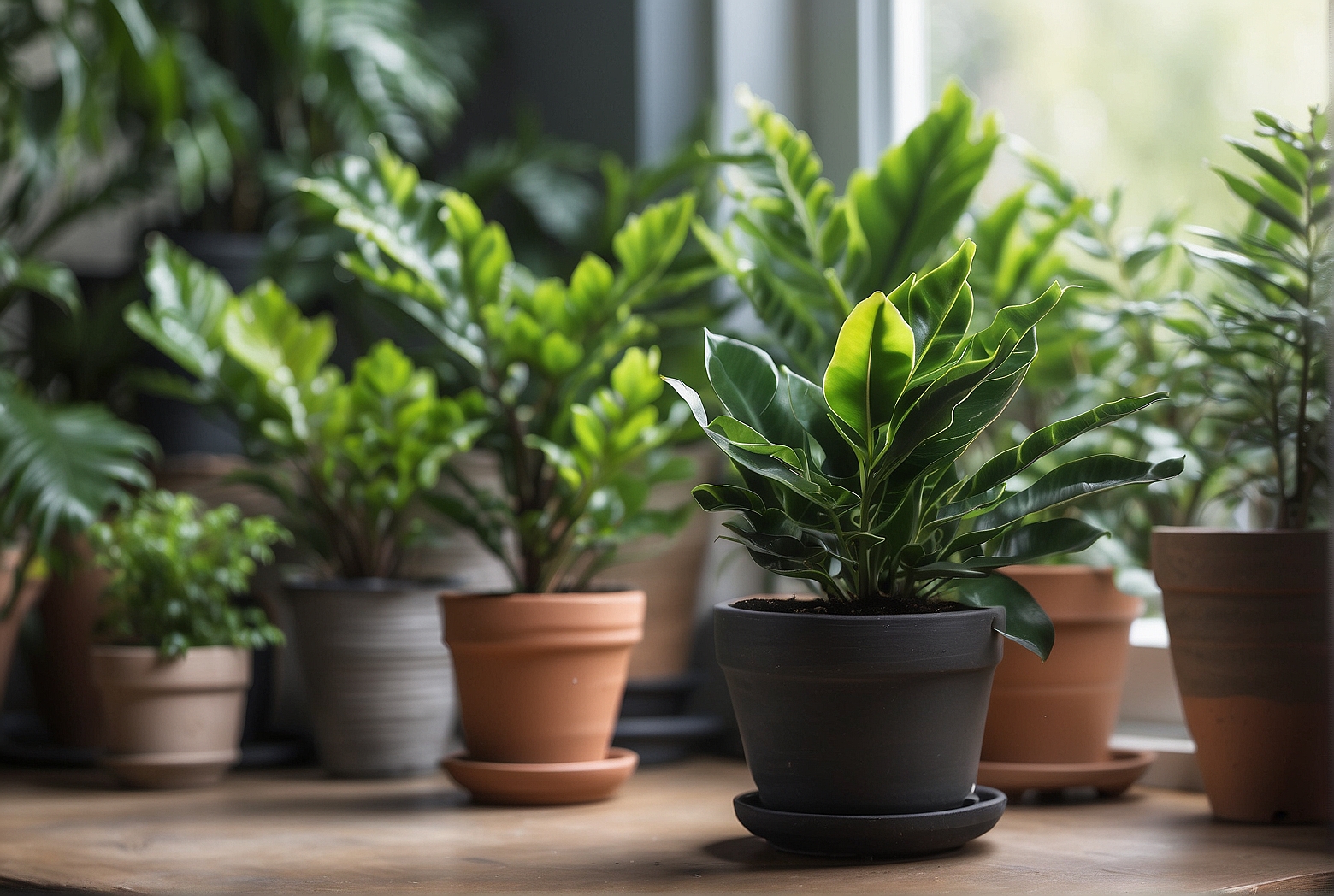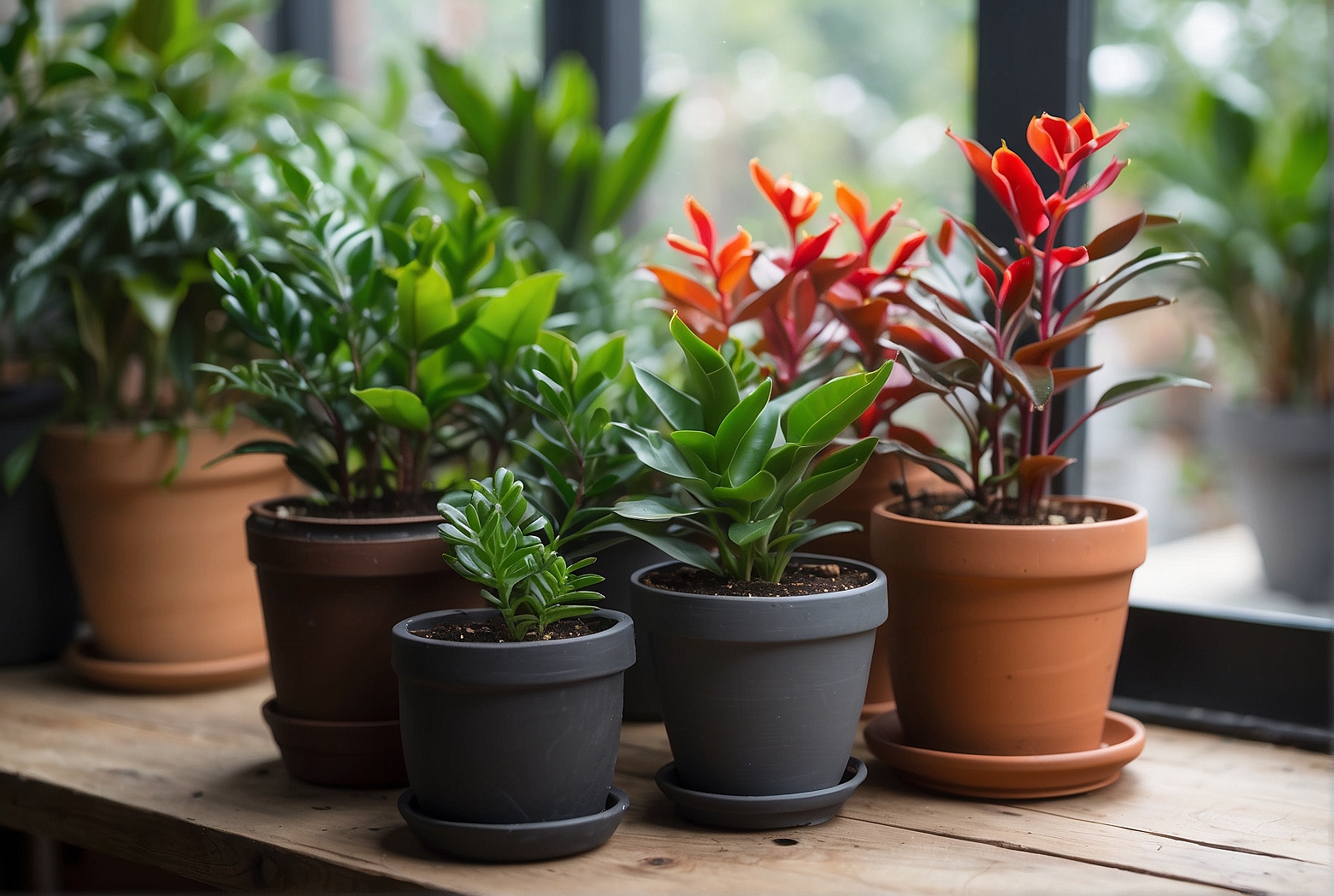Last Updated on April 12, 2024 by Tony Manhart
Are you looking for a low-maintenance houseplant that adds a touch of greenery to your home or office? Look no further than ZZ plants! Known for their resilience and ability to thrive in various conditions, ZZ plants are often touted as one of the easiest plants to care for. Whether you have a busy schedule, a black thumb, or are a beginner in the world of gardening, ZZ plants might just be the perfect fit for you. With their glossy, dark green leaves and minimal water requirements, these plants are sure to charm even the least experienced plant keepers. Discover the effortless beauty of ZZ plants as we explore their care tips and the wonderful benefits they bring to any space.
About ZZ Plants
Origin and Description
ZZ plants, also known as Zamioculcas zamiifolia, are native to eastern Africa. They belong to the aroid family, Araceae, and are known for their attractive glossy leaves and upright growth habit. The leaves of ZZ plants are composed of multiple leaflets that grow in a pinnate arrangement, giving them a feather-like appearance. These plants can grow up to three feet tall and have a spread of two to three feet. They are often chosen for their unique foliage and ability to thrive in low-light conditions.
Benefits and Uses
ZZ plants have gained popularity not only for their aesthetic appeal but also for the benefits they offer. One of the primary benefits of ZZ plants is their ability to purify the air. They have been shown to effectively remove toxins such as benzene, xylene, and toluene from indoor environments. This makes them an excellent choice for improving indoor air quality and creating a healthier living or working space.
Additionally, ZZ plants are low maintenance and can thrive in a variety of conditions. Their ability to tolerate low-light conditions and their resistance to pest infestations make them an ideal choice for beginners or those with a busy lifestyle. ZZ plants can be used as decorative indoor plants, in office spaces, or even in landscaping projects, adding a touch of greenery to any environment.

Ideal Growing Conditions
Light Requirements
ZZ plants are well-known for their ability to survive in low-light conditions, making them an excellent choice for indoor environments with limited natural light. They can tolerate a range of light conditions, from bright indirect light to shade. However, ZZ plants prefer medium to bright indirect light to maintain their best growth and foliage color. Placing them near a window with filtered sunlight or in a well-lit room would provide them with the optimal light conditions.
Temperature and Humidity
ZZ plants are native to regions with warm climates, so they prefer temperatures between 65°F and 75°F (18°C to 24°C). They can tolerate slightly higher or lower temperatures but may suffer if exposed to extreme hot or cold conditions for extended periods. As for humidity, ZZ plants can adapt well to average indoor humidity levels. They do not require specific levels of humidity and can thrive in environments with normal humidity found in most households.
Soil and Potting
When it comes to soil, ZZ plants prefer well-draining potting mixes. A well-balanced potting mix with a combination of peat moss, perlite, and a small amount of sand is an ideal choice. This type of soil mixture promotes healthy root growth and prevents overwatering, which can lead to root rot. It’s important to ensure the pot has drainage holes to allow excess water to escape and prevent waterlogged soil.
Watering
One of the reasons ZZ plants are considered low maintenance is their ability to tolerate periods of drought. They have succulent-like qualities, storing water in their thick rhizomes. It is essential to allow the soil to dry out between waterings to prevent overwatering, which can cause root rot. When watering, thoroughly saturate the soil and allow it to dry out before watering again. As a general rule of thumb, watering once every two to three weeks is usually sufficient, but this may vary depending on factors such as light levels and temperature.

Fertilization
ZZ plants have minimal nutritional needs, and excessive fertilization can lead to salt accumulation in the soil, causing harm to the plant. Applying a balanced, water-soluble fertilizer diluted to half strength once every three to four months during the growing season (spring and summer) should be sufficient. It’s important to follow the instructions provided with the fertilizer to avoid over-fertilization, which can lead to burnt leaf tips.
Propagation
Division
Propagating ZZ plants through division is a common and successful method. To divide a ZZ plant, carefully remove it from its pot and shake off excess soil to expose the rhizomes. Using a clean, sharp knife, divide the plant into sections, making sure each section has a healthy rhizome and several shoots. Plant each section in a separate pot with well-draining soil and water sparingly until new growth becomes apparent. Division should be done during the spring or summer when the plant is actively growing.
Leaf Cuttings
Another propagation method for ZZ plants is through leaf cuttings. To propagate ZZ plants using this method, select a healthy leaf and cut it into sections, ensuring each section contains a portion of the leaf stem. Allow the cut ends of the leaf sections to callus over for a few days to reduce the risk of rotting. Plant the leaf sections in a well-draining soil mixture and provide them with a warm and humid environment. Keep the soil slightly moist, and within a few weeks, new shoots should emerge from the leaf sections.
Common Care Mistakes
Overwatering
Overwatering is one of the most common care mistakes for ZZ plants. These plants are adapted to withstand periods of drought, and their rhizomes store water. Too much water can lead to root rot and cause the plant to decline. It’s crucial to allow the soil to dry out between waterings and avoid keeping the soil overly wet.
Underwatering
While ZZ plants can withstand drought, consistently underwatering them can cause dehydration and lead to wilted or yellowing leaves. It’s important to find a balance and water them regularly, allowing the soil to dry out slightly between waterings. Monitor the plant’s moisture levels and adjust the watering frequency accordingly.
Inadequate Light
Although ZZ plants can tolerate low-light conditions, inadequate light can lead to weak or leggy growth. Placing the plants in areas with insufficient light can cause the leaves to lose their vibrant green color and become pale. It’s important to provide ZZ plants with enough light, preferably medium to bright indirect light, to maintain their healthy growth and appearance.
Improper Soil
Using the wrong type of soil or a soil mixture without proper drainage can cause issues for ZZ plants. They require well-draining soil to prevent waterlogged conditions that can lead to root rot. Choosing a potting mix specifically formulated for indoor plants or creating a well-balanced mixture is crucial for the plant’s overall health and growth.
Pests and Diseases
ZZ plants are relatively resistant to pests and diseases. However, they can occasionally be susceptible to mealybugs, spider mites, and aphids. Regularly inspecting the plant for signs of infestation, such as webs, sticky residue, or visible insects, is important. If pests are present, treating the plant with an appropriate insecticide or using natural remedies like neem oil can help eliminate the infestation.
Troubleshooting
Yellowing Leaves
Yellowing leaves on a ZZ plant can indicate various issues. Overwatering, inadequate light, or nutrient deficiencies can all contribute to yellowing foliage. It’s important to evaluate the plant’s watering routine, light exposure, and ensure it is receiving appropriate nutrients to address this concern. Adjusting these factors can help prevent further yellowing and promote healthier growth.
Wilting
Wilting leaves can be a sign of underwatering or overwatering. It’s essential to assess the watering routine and adjust accordingly. If the soil is consistently dry, increasing the frequency of watering may help. On the other hand, if the soil is consistently wet, reducing watering frequency and allowing the soil to dry out between waterings can help alleviate wilting.
Brown Spots
Brown spots on ZZ plant leaves can be caused by a few factors, including overwatering, cold drafts, or excessive sunlight. It’s crucial to examine the plant’s watering practices, ensure it is not located in a cold or drafty area, and provide appropriate light levels. Adjusting these conditions can prevent the occurrence of brown spots and promote healthier foliage.
Root Rot
Root rot is a serious concern for ZZ plants and is typically caused by overwatering or poorly draining soil. If the plant displays symptoms such as yellowing leaves, wilting, or a foul odor emanating from the soil, root rot may be present. To treat root rot, it’s important to remove the affected parts of the plant and repot it in fresh, well-draining soil. Adjusting the watering routine and ensuring proper soil drainage moving forward will help prevent the recurrence of root rot.
ZZ Plant Varieties
Zamioculcas zamiifolia ‘Raven’
The ZZ plant variety known as ‘Raven’ is a striking cultivar with deep, dark green, almost black, leaves. Its unique foliage adds a touch of elegance and drama to any indoor space. This variety maintains all the easy-care qualities of the ZZ plant, making it an excellent choice for those looking to add a touch of sophistication to their plant collection.
Zamioculcas zamiifolia ‘Zenzi’
The ‘Zenzi’ variety of ZZ plant is a smaller and more compact cultivar compared to the standard ZZ plant. It features shorter and wider leaflets, giving it a different appearance. This variety is perfect for those who want a more petite version of the ZZ plant or need a plant that fits well in smaller spaces.
Zamioculcas zamiifolia ‘Black Raven’
The ‘Black Raven’ variety is another captivating cultivar with dramatic dark foliage, resembling its ‘Raven’ counterpart. However, the ‘Black Raven’ variety stands out with its slightly smaller-sized leaves, making it a popular choice for those who want a ZZ plant with a twist.
Zamioculcas zamiifolia ‘Zamicro’
The ‘Zamicro’ variety is a miniature form of the classic ZZ plant. It features all the same characteristics as its larger counterpart but grows up to half the size. This compact variety is perfect for those with limited space or who prefer smaller plants. Its attractive foliage and low maintenance nature make it an ideal addition to any indoor environment.
Decorative Uses
Indoor Decoration
ZZ plants are commonly used as indoor decorative plants due to their striking appearance and ability to thrive in various light conditions. They can be placed in living rooms, bedrooms, or even bathrooms, as long as sufficient light and appropriate watering are provided. Whether used as standalone plants or combined with other indoor plants, ZZ plants can instantly elevate the aesthetics of any room, adding a touch of greenery and elegance.
Office Spaces
Having plants in office spaces provides numerous benefits, including improved air quality and reduced stress levels. ZZ plants are an excellent choice for office environments due to their ability to tolerate low-light conditions and minimal care requirements. They can thrive with artificial lighting and infrequent watering, making them ideal for busy office settings where regular plant maintenance may not be possible.
Landscaping
While ZZ plants are primarily known as indoor plants, they can also be used effectively for landscaping in suitable climates. In tropical or subtropical regions, ZZ plants can be incorporated into outdoor gardens and landscape designs, adding texture and a unique, exotic touch. They work well when planted as borders or as part of a lush, green backdrop for other flowering plants or shrubs.
ZZ Plants and Air Quality
Air Purification
One of the significant benefits of ZZ plants is their ability to purify the air. They have been shown to effectively remove toxins such as benzene, xylene, and toluene from indoor environments. These chemicals are commonly found in indoor spaces due to factors like furniture, cleaning products, and building materials. By having ZZ plants in your home or workplace, you can reduce the levels of these harmful substances and create a healthier atmosphere.
Humidity Regulation
In addition to air purification, ZZ plants also contribute to regulating humidity levels in indoor environments. While not as efficient as dedicated humidifiers, the moisture released through transpiration by the plant can help increase the humidity slightly. This can be beneficial, especially during dry seasons or in regions with low humidity. The natural humidity regulation properties of ZZ plants contribute to a more comfortable and healthier indoor environment.
Low Maintenance Plant
Drought Tolerance
One of the key characteristics that make ZZ plants appealing to many plant enthusiasts is their ability to withstand periods of drought. These plants have adapted to dry conditions by storing water in their rhizomes. This means they can survive for extended periods without watering, making them an excellent choice for those who often forget to water their plants or those who travel frequently.
Slow Growth
Another advantage of ZZ plants is their relatively slow growth rate. While some plant lovers enjoy the rapid growth of their green companions, others prefer a more contained growth habit. ZZ plants grow steadily but slowly, allowing them to maintain a manageable size over time. This slow growth rate reduces the need for frequent pruning or repotting, making them an ideal choice for those who prefer low maintenance plants.
Minimal Pruning
ZZ plants are known for their naturally neat and attractive appearance, with the glossy, feather-like leaves growing symmetrically from the base. Their slow growth rate means they rarely require pruning. Occasional removal of any dead or yellowing leaves is usually sufficient to keep the plant looking tidy. This minimal pruning requirement further adds to the low maintenance nature of ZZ plants, making them an attractive option for those who prefer plants that require minimal attention.
Conclusion
ZZ plants are an excellent choice for both beginner and experienced plant enthusiasts due to their attractive appearance, air-purifying qualities, and low maintenance nature. Originating from Africa, these plants have adapted to a variety of growing conditions, allowing them to thrive in different settings. Whether placed indoors as decorative plants or incorporated into outdoor landscapes, ZZ plants offer a touch of elegance and greenery. With proper care and attention to their light, watering, and soil requirements, ZZ plants can flourish and add beauty to any environment. So why not add a ZZ plant to your collection and enjoy the benefits it brings?
Tony Manhart is a passionate gardener who has been tending to gardens for over 20 years. He takes pride in creating beautiful outdoor spaces with plants, trees, and shrubs that can thrive in any environment. He loves to share his knowledge with others and has taught classes on gardening basics and advanced techniques. He is committed to sustainability, using natural and organic methods to create and maintain gardens. He also works with local organizations to create green spaces for communities. When he’s not gardening, Tony enjoys hiking, reading, and spending time with his family.


